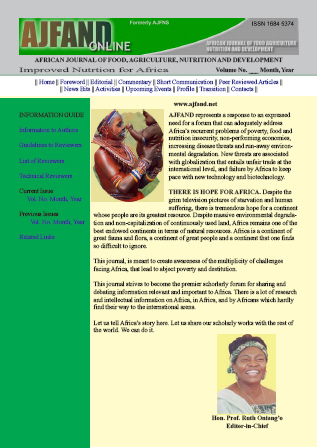
|
African Journal of Food, Agriculture, Nutrition and Development
Rural Outreach Program
ISSN: 1684-5358
EISSN: 1684-5358
Vol. 7, No. 1, 2007
|
 Bioline Code: nd07002
Bioline Code: nd07002
Full paper language: English
Document type: Research Article
Document available free of charge
|
|
|
African Journal of Food, Agriculture, Nutrition and Development, Vol. 7, No. 1, 2007
| fr |
Emmanuel Ohene Afoakwa, Samuel Sefa-Dedeh, Agnes Simpson Budu, Esther Sakyi-Dawson & Justice Asomaning
Résumé
La fermentation spontanée a été identifiée pour améliorer les caractéristiques de la qualité des aliments qui en dérivent. Lorsqu'elle est combinée avec la fortification et la nixtamalisation du petit pois, elle est supposée améliorer les qualités nutritionnelles, fonctionnelles, physico - chimiques et sensorielles des aliments dérivés du maïs et, de ce fait, elle améliore les qualités et élargit les techniques de traitement des aliments en Afrique subsaharienne. La présente enquête avait donc pour but d'étudier l'influence de la fermentation spontanée sur les caractéristiques fonctionnelles, physico - chimiques et sensorielles des aliments dérivés du maïs nixtamalisés fortifiés avec du petit pois. Une expérience factorielle de 3x3x2 avec le temps de fermentation (0, 24, 48 h), le petit pois (0, 10 et 20%) et le traitement alcalin (maïs nixtamalisé et non - nixtamalisé), a été utilisée. Des échantillons ont été analysés pour mesurer la teneur en pH, l'acidité titrable et la capacité d'absorption de l'eau (27°C et 70°C). Les mélanges ont été séchés en utilisant un coffre de séchage, moulus en farine et traités pour produire des casse-croûte. Le test de sondage de cylindre a été utilisé dans un analyseur de texture TA -TX2 pour mesurer la dureté des casse-croûte traités, et une analyse sensorielle a été menée pour déterminer l'acceptabilité de ces amuse-gueule. Le pH de tous les échantillons nixtamalisés diminuait avec le temps de fermentation et la fortification du petit pois avec l'accroissement concomitant de l'acidité titrable. L'addition du petit pois a causé des diminutions dans le pH passant de 9,68 à 6,12 dans les échantillons nixtamalisés non fermentés. Contrairement à cette tendance, les accroissements généraux de l'acidité titrable ont été observés avec la fermentation et l'addition du petit pois aux produits. Les capacités d'absorption de l'eau à 27°C et 70°C de tous les mélanges nixtamalisés diminuaient généralement avec le temps de fermentation et la fortification du petit pois. La texture (dureté) des produits formulés était acceptable. L'évaluation sensorielle a indiqué que les techniques de nixtamalisation, de fermentation et de fortification du petit pois utilisées pour le traitement des produits n'ont pas influencé leur acceptabilité par le panel. Le maïs nixtamalisé peut donc être soumis à la fermentation spontanée avec la fortification du petit pois pour améliorer les propriétés fonctionnelles, physico - chimiques et sensorielles des produits qui en dérivent, de ce fait servant comme des technologies alimentaires alternatives au traitement du maïs en Afrique subsaharienne.
Mots Clés
Maïs, fermentation, fortification du petit pois, nixtamalisation, propriétés fonctionnelles.
|
| |
| en |
INFLUENCE OF SPONTANEOUS FERMENTATION ON SOME QUALITY CHARACTERISTICS OF MAIZE-BASED COWPEA-FORTIFIED NIXTAMALIZED FOODS
Emmanuel Ohene Afoakwa, Samuel Sefa-Dedeh, Agnes Simpson Budu, Esther Sakyi-Dawson & Justice Asomaning
Abstract
Spontaneous fermentation has been identified to improve the quality characteristics of foods derived from them. When combined with cowpea fortification and nixtamalization, it is expected to improve the nutritional, functional, physico-chemical and sensory qualities of maize based foods thereby improving the qualities as well as broadening the food processing techniques in sub-Saharan Africa. This study was therefore aimed at investigating the influence of spontaneous fermentation on the functional, physico-chemical and sensory characteristics of maize-based cowpea-fortified nixtamalized foods. A 3x3x2 factorial experiment with fermentation time (0, 24, 48 h), cowpea (0, 10 and 20%) and alkaline treatment (nixtamalized and non-nixtamalized maize) was used. Samples were analyzed for pH, titratable acidity and water absorption capacity (27°C and 70°C). The blends were dried using the cabinet drier, milled into flour and processed into a snack food. The cylinder probe test was used in a TA-TX2 Texture Analyzer to measure the hardness of processed snack foods and sensory analysis was conducted to determine the acceptability of the snack products. The pH of all the nixtamalized samples decreased with fermentation time and cowpea fortification with concomitant increase in titratable acidity. Cowpea addition caused decreases in the pH from 9.68 to 6.12 in the unfermented nixtamalized samples. Contrary to this trend, general increases in titratable acidity were observed with fermentation and cowpea addition of the products. The water absorption capacities at both 27°C and 70°C of all the nixtamalized blends generally decreased with fermentation time and cowpea fortification. The texture (hardness) of the formulated products were acceptable. Sensory evaluation indicated that the techniques of nixtamalization, fermentation and cowpea fortification used for the processing of the products did not influence their acceptability by the panel. Nixtamalized maize can therefore be subjected to spontaneous fermentation with cowpea fortification to enhance the functional, physico-chemical and sensory properties of products derived from them, thereby serving as alternative food technologies to maize processing in sub-Saharan Africa.
Keywords
Maize, fermentation, cowpea-fortification, nixtamalization, functional properties.
|
| |
© Copyright 2007 -Rural Outreach Program
Alternative site location: http://www.ajfand.net/
|
|
